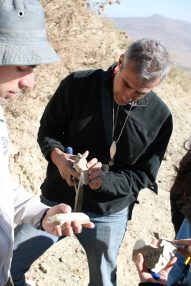Scientists Find Eternal Nile To Be More Ancient Than Previously Thought
November 11, 2019

Ancient Egyptians considered the Nile river to be the source of all life. The steady northward path of the river has nourished the fertile valleys of northeast Africa for millions of years and in doing so, shaped the course of human civilization.
The Nile’s unchanging path, however, has been a geologic mystery because long-lived rivers usually move over time. Researchers at The University of Texas at Austin have cracked the case by linking the river’s flow to the movement of rock in the Earth’s deep mantle. In the course of their investigation, they found the eternal river to be much older than anyone realized, with the scientists estimating the age of the Nile to be 30 million years – about six times as long as previously thought.
The research, published on Nov. 11 in the journal Nature Geoscience, found that if it weren’t for the mantle movement keeping the river on course, the Nile would have turned west long ago, probably changing the course of history along with it.
“One of the big questions about the Nile is when it originated and why it has persisted for so long,” said lead author Claudio Faccenna, a professor at the UT Jackson School of Geosciences. “Our solution is actually quite exciting.”

The results should settle a long-running debate about the age of the river and provide evidence that the slow movement of the deep mantle is one of the key forces shaping our Earth’s landscape and geological processes. The Earth’s mantle is composed of solid rock that flows like a fluid over long periods. Like currents in an ocean, different areas of the mantle have different circulation patterns.
The research team included Jackson School scientists Petar Glisovic, who is now a research collaborator at the University of Quebec; and Thorsten Becker, a professor at the Jackson School and research scientist at its University of Texas Institute for Geophysics, where Faccenna is also a research scientist. Other collaborators include researchers from the University of Florida, the University of Milano-Bicocca, the Geological Survey of Israel and the Hebrew University of Jerusalem.
In the paper, the researchers connected the tilted nature of the Nile’s topography to a conveyor belt of mantle rock pushing up against the Ethiopian Highlands in the south and pulling the surface down in the north. From beginning to end, the gentle gradient keeps the Nile on a consistent northward course.
The research involved tracing the geological history of the Nile by studying ancient volcanic rock in the Ethiopian Highlands and correlating it with enormous deposits of river sediment buried under the Nile Delta. This told the researchers that after rising dramatically, the Ethiopian Highlands have remained at a similar height for millions of years, which the researchers attribute to the support of the mantle rock from below.
“We know that the high topography of the Ethiopian plateau was formed about 30 million years ago,” Becker said.
Until now, however, it was unclear how this topography has been maintained for so long.
The team verified their findings using computer simulations that re-created 40 million years of Earth’s plate tectonic activity.
The model showed the arrival of a hot mantle plume that probably led to the outpouring of lava that formed the Ethiopian Highlands while activating a conveyor belt in the mantle that persists to this day. The simulation reproduced changes in the landscape almost exactly as the scientists had expected – including small details in the landscape such as whitewater rapids found along the length of the Nile.
The ability of the model to refine such small details was a big surprise and a significant research finding, said Glisovic.
“I think this technique gives us something we didn’t have in the past,” he said.
Eric Kirby, a professor at Oregon State University and an expert in uplifting landscapes, said that combining diverse geological data with state-of-the-art, geophysical modeling was key for the research.
“Without either piece, you wouldn’t get such a compelling result,” said Kirby, who was not involved in the study.
The team now hopes to apply the technique to other rivers such as the Yangtze and Congo. The research was supported by NASA and a grant from the Italian government’s Ministry of Education, University and Research.
For more information, contact: Anton Caputo, Jackson School of Geosciences, 512-232-9623; Monica Kortsha, Jackson School of Geosciences, 512-471-2241.
